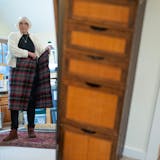After 17 happy years at the Weisman Art Museum in Minneapolis, the chickens are flying off to Armenia. Yes, Armenia.
That would be the caged chickens painted by Doug Argue, a Minnesota-born, New York-based artist. The untitled picture -- 12 feet tall and 18 feet wide -- known informally as "the chicken painting" has been a popular attraction since 1995, when its owner, Gerard Cafesjian, then a St. Paul legal-publishing executive, lent it to the University of Minnesota museum. He plans to send it to his namesake Cafesjian Center for the Arts in Yerevan, Armenia's capital.
Fans are invited to stop by Sunday, say goodbye and leave a comment or record a favorite memory of the picture before it departs Monday. Because it is so big, it will be removed from its stretcher-frame and rolled up for shipping.
"I love the Weisman, and think it's been great there," Argue said, "but at the same time I'm eager to see it in Armenia. I'm curious what people will think of it there."
The Cafesjian Center for the Arts, which opened in 2009, is a lavishly appointed American-style museum with elegant galleries, a shop and a jazz club. An Armenian-American who now lives in Naples, Fla., Cafesjian had the building incorporated into a Soviet-era "cascade," a huge terraced park whose construction had stalled when the U.S.S.R. disintegrated and Armenia found itself economically and politically adrift. His Cafesjian Museum Foundation reportedly invested more than $35 million to complete the "cascade" and add the museum, designed by David Hotson Architects, a New York firm.
The New York Times described the project as "a mad work of architectural megalomania and architectural recovery ... one of the strangest and most spectacular museum buildings to open in ages."
According to the center's website, it had more than 1.2 million visitors in 2011. It primarily shows art owned by the Brooklyn-born collector, including sculpture by Barry Flanagan, paintings by Jennifer Bartlett and Archile Gorky, glass by Dale Chihuly and other Americans as well as international talents.
Crazy, made-up chickens


